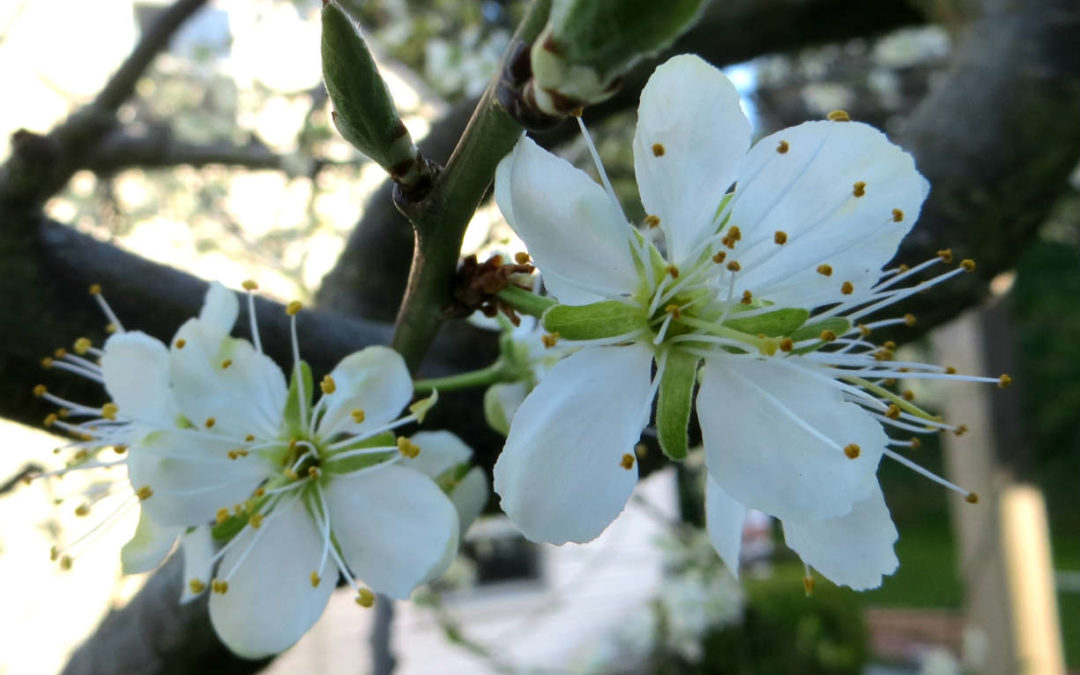Summer is here. Saturday, May 23rd, I bought my first flat of Skagit Valley’s fresh Hayton Farms organic strawberries. I can’t remember ever buying local strawberries this early. Some seasons, I’ve had to wait until the first week of July!
Symphonic Spring
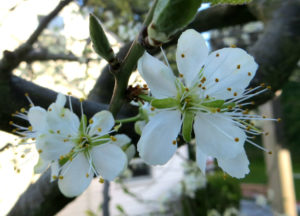
Italian Prune Plum Blossoming in March
Typically, April and May were months where Seattleites would be tantalized by our symphonic spring. Unlike my Connecticut upbringing where spring arrived like the 4th of July, quickly and with vigor, the classic maritime spring is punctuated by gorgeous days and temperatures gradually rising often times between what feels like endless days of clouds. Expecting summer imminently, usually when June comes, we are socked in with “June Gloom” or “Juneuary” amid low-hanging clouds until after the 4th of July. Outdoor events are scheduled after July 5th, when magically, the giant weather switch in the sky changes and summer officially begins. Summer lasts about 2-1/2 months until mid-September, with little rain and lots of sunshine! However, contrary to the norm, this year the first week in May week had temperatures over 80 degrees! And now, traipsing into June, temperatures are hovering near 80 again!
Another anomaly this year, ski season was cut short. Not enough snow. If there was snow, it was only above 5,000 feet at Crystal and Stevens ski areas. I ski to get into that meditative zone–just the swish of the ski, the pounding of my heart, and cool wind brushing past my face. My last ski day was in January in the sun, on crunch, avoiding rocks–oh, so loud and not fun!
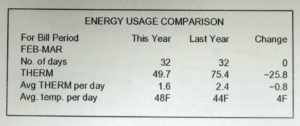
March 2015 Gas Energy Usage
My February 7th to March 10th Puget Sound Energy gas bill confirmed the bad ski season. The weather is different, changing, and four degrees warmer than the previous winter which significantly reduced my energy consumption and my bill! Daily temperatures have continued to increase and since April, I’ve been sleeping with the window open and the fan on! It has just been too hot! Continuing this trend, according to latest forecasts from the National Oceanic and Atmospheric Administration (NOAA) Climate Forecast System surface air temperatures for this Seattle summer (June, July and August) are expected to be two to four degrees Fahrenheit above normal, which would give us on average 80 degree days and 60 degree nights! It sounds divine for growing food, but not for cooling off our city homes. With weather and predictions like this, it is time to plant your tomatoes, as it will not be the “year of the green tomato!” (Oh, and buy a fan, too, before they are sold out!)
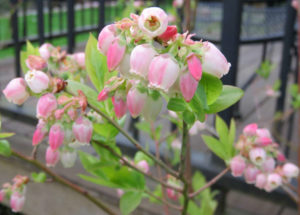
March Blooming Hedge Blueberries
Not surprisingly, Governor Inslee on May 15th declared a statewide drought. This past winter, Seattle had normal quantities of precipitation, but it came as rain rather than snow–hence, the bad ski season. The Pacific Northwest is dependent on snow and thus, snowmelt to quench a thirsty populous. Snow typically accumulates in the Cascades and Olympics through the winter, creating a defacto giant frozen reservoir. With warming temperatures and sunny days, melting snow feeds drinking water reservoirs, irrigation channels, and salmon-bearing streams. The statewide snowpack is only nine percent of normal according the Washington State Department of Ecology, and currently predicted to be the lowest on record in the past 64 years. As of May 29th, there is no snowpack in the Olympic Mountains. According to Cliff Mass, Professor of Atmospheric Science at the University of Washington and regular commentator on KUOW-our public radio station, western Washington public water systems are predicted to have enough water due to foresight from operators that filled reservoirs with rainwater during the winter. With sufficient water supply and sunny warm days ahead, if you plant your yard with edibles, anticipate a bountiful harvest.
Rather than pining for the cool summers of past or worrying about the hot summers of the future, embrace NOW with gusto and eat (and perhaps, grow) good food!
Eat Good Food!
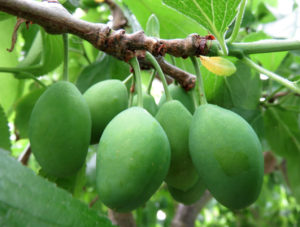
Late May Prune Plums
I am looking forward to a plethora of great food from my yard. My perennials are rhubarb, rosemary, Italian prune plums, thyme, blueberries, strawberries, and Interlaken grapes. Plums, arriving in late August, are a staple for my annual zwetchendatschi–the plum tart of my Bavarian heritage. Any over abundance of plums and grapes are dried into prunes and raisins. Annually, garlic, tomatoes, green beans, basil, snap peas, and Japanese cucumbers flourish in my garden. My tomato starts are chosen based on the fruit not growing beyond two inches round to ensure they ripen. My favorites, Stupice for slicing, San Marzano for salsa, and any grape, cherry, and pear tomatoes for salads. I grow what will thrive! It is a joy to see my good food yard!
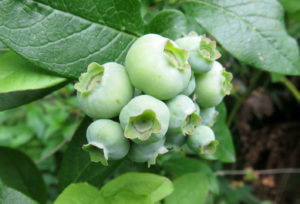
Late May Low-Bush Blueberries
Farmer’s markets are my salvation for all those delectables I don’t or can’t grow on a 5,000 square foot city lot. Ever since my cabbage moth infestation, I am dependent on farmers to grow my brassicas–kales, chards, and broccoli. Organic farmers minimize pest problems by having enough land to rotate their crops between different fields every four to 13 years. Bad bugs never have a chance to set up camp and grow big families, since their favorite food group keeps moving fields. A legume planting is also part of the rotation sequence to naturally introduce nitrogen back into the soil. With so little real estate and unwillingness to use pesticides, I just abandon crops when pests invade. I will grow brassicas again when I know the bugs have left for new haunts. Hot weather crops, like melons, high acreage products such as corn, and large fruit trees are virtually impossible to grow on a Seattle city lot and all are purchased from my local farmer.
I could fret about the days that just seem too warm, but instead, I savor yesterday, tend for tomorrow, and eat for today.
Kathryn Gardow, P.E., is a local food advocate, land use expert and owner of Gardow Consulting, LLC, an organization dedicated to providing multidisciplinary solutions to building sustainable communities. Kathryn has expertise in project management, planning, and civil engineering, with an emphasis on creating communities that include food production. Kathryn is a Washington Sustainable Food and Farming Network board member and on the Urban Land Institute–Northwest District Council’s Center for Sustainable Leadership planning team. Kathryn’s blog muses on ways to create a more sustainable world and good food!

